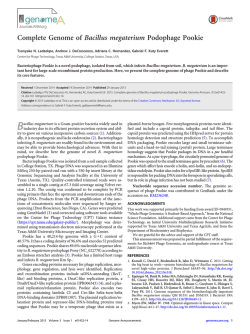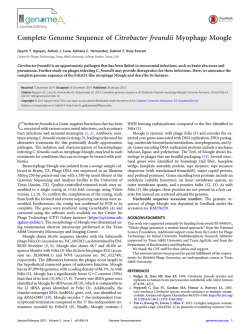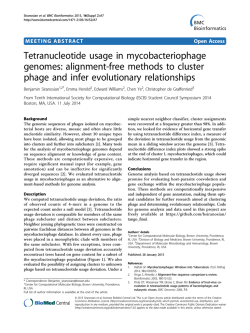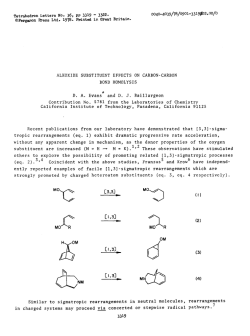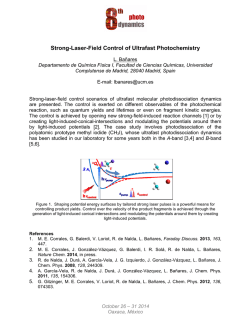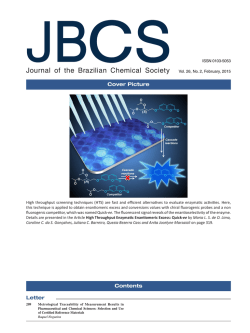
Antiviral activity evaluation of some pyrimidine derivatives using
Available online www.jocpr.com Journal of Chemical and Pharmaceutical Research, 2015, 7(1):289-293 Research Article ISSN : 0975-7384 CODEN(USA) : JCPRC5 Antiviral activity evaluation of some pyrimidine derivatives using plaque reduction assay Abolghasem Danesh3*, Javad Behravan1 and Mohammad Ramezani2 1 2 Biotechnology Research Center, Mashhad University of Medical Sciences, Mashhad, Iran Pharmaceutical Research Center, Mashhad University of Medical Sciences, Mashhad, Iran 3 Azadi Square, University Campus, School of Pharmacy, Mashhad, Iran _____________________________________________________________________________________________ ABSTRACT The antiviral effects of some pyrimidine derivatives were investigated using plaque reduction assay. Pyrimidine derivatives were dissolved in suitable vehicles and different concentrations of each compound were prepared. After several enriching stages of phage CP51, the phage numbers in phage lysates were determined. To ascertain whether pyrimidine derivatives have the ability to inhibit viral adsorption to the host cell, or to affect the phage during the lytic cycle, the reactions were pre-incubated with the phage CP51 for 30 min at 25°C, followed by addition of inoculum containing 5h liquid culture of Bacillus cereus. The growth and reproduction of phage was inhibited significantly at 333 µg/ml and 133 µg/ml by the first and third derivatives (MMNPAPP and MNPPAPP), respectively. These results indicate that the MMNPAPP and MNPPAPP had substantial antiviral activity. Key words: Pyrimidine derivatives, Antiviral effect, Plaque reduction assay. _____________________________________________________________________________________________ INTRODUCTION Viral diseases, including emerging and established viruses, are increasing worldwide health concerns [1]. The discovery of new antiviral agents has been absorbed a lot of research-attention. One strategy to search for useful and novel antiviral agents is to screen new synthesized chemical entities. Pyrimidine has a heterocyclic aromatic structure similar to benzene and pyridine. Its six-membered ring contains two nitrogen atoms at positions 1 and 3. [2] Pyrimidine derivatives form a component in a number of useful drugs [2] and are associated with many biological and therapeutical activities [2]. Condensed pyrimidine derivatives have been reported to have anti-microbial [3], analgesic, anti-inflammatory [4], anti-HIV [5], anti-tubercular [6], antitumor [7], anti-malarial [8], diuretic [9] and cardiovascular activities [10]. Pyrimidine derivatives are also used as hypnotic drugs [11], calcium-sensing receptor antagonists [12] and also as antagonists of the human adenosine receptor [13-15]. This broad biological spectrum of pyrimidine derivatives has been emerged from its synthetically versatile structure which allowed the generation of diverse derivatives by substitution of different group at C2/C4/C5/C6 carbon positions and derivatization of the pyrimidine nitrogen. The antiviral activity of some pyrimidine derivatives has been reported [16-18]. The attempt described here studied the antiviral activity of some novel synthetic pyrimidine derivatives against phage CP51 as an indicator using phage-plaque reduction method. 289 Abolghasem Danesh et al J. Chem. Pharm. Res., 2015, 7(1):289-293 ______________________________________________________________________________ EXPERIMENTAL SECTION Pyrimidine derivatives Pyrimidine derivatives were synthesized in the Ferdowsi University of Mashhad, Iran, and for the evaluation of antiviral activity were delivered to the School of Pharmacy, Mashhad University of Medical Sciences, Iran. These derivatives that their synthesis process was previously reported [19] include MMNPAPP, MMNPAP, MNPPAPP, DAMNPAPP. Their full IUPAC nomenclatures are: (1) 2-(4-methyl-6-morpholino-5-nitropyrimidin-2-ylamino)-3-phenylpropanoic acid (2) 2-(4-methyl-6-morpholino-5-nitropyrimidin-2-ylamino)-propanoic acid (3) 2-(4-methyl-5-nitro-6-(pyrrolidin-1-yle)-pyrimidin-2-ylamino)-3-phenylpropanoic acid (4) 2-(4-(diethyl amino)-6-methyl-5-nitropyrimidin-2-ylamino)-3-phenylpropanoic acid. CH3 CH3 NO2 COOH H NO2 N COOH H N N H N N H 3C O N N N H O MMNPAP: 2-(4-methyl-6-morpholino-5-nitropyrimidin-2-ylamino)propanoic acid MMNPAPP: 2-(4-methyl-6-morpholino-5-nitropyrimidin-2ylamino)-3-phenylpropanoic acid CH 3 CH3 NO2 NO 2 COOH H N H COOH H N N N H N N N N CH3 H3C MNPPAPP : 2-(4-methyl-5-nitro-6-(pyrrolidin-1-yle)-pyrimidin-2ylamino)-3-phenylpropanoic acid DAMNPAPP: 2-(4-(diethyl amino)-6-methyl-5-nitropyrimidin-2-yl amino)-3-phenylpropanoic acid Figure 3: Chemical structure of pyrimidine derivatives. They are synthesized with an identical core (5-nitro pyrimidine), but different groups attached to C2 and C6 positions of pyrimidine ring. Preparing stock solutions of pyrimidine derivatives and antiviral drugs The first and second compounds were dissolved in the 5 mg/ml and 2 mg/ml sodium bicarbonate solution, respectively, to obtain the final concentration of 1 mg/ml of both stock solutions, while the final concentration of 0.8 mg/ml was achieved for the third one by dissolving the compound in 15 mg/ml sodium bicarbonate solution with 30 minutes continuous stirring at room temperature. The presence of DMSO was necessary for dissolving the fourth derivative. In the mixture solution of sodium bicarbonate (20 mg/ml) and DMSO (5% v/v), final concentration of 0.4 mg/ml of the fourth compound was obtained. Trifluridine stock solution: trifluridine eye drop (3 mg/ml) was used as a stock solution. Culture media Phage Assay Broth (PA Broth) contained nutrient broth: 13 g/L (Merck, Germany), NaCl: 5 g/L (Merck, Germany), CaCl2. 2H2O: 0.015 g/L, MgSO4.7H2O: 0.020 g/L, MnSO4. H 2 O: 0.010 g/L and pH was adjusted to 5.6-6.0 in all 290 Abolghasem Danesh et al J. Chem. Pharm. Res., 2015, 7(1):289-293 ______________________________________________________________________________ the protocols. Phage Assay Agar (PA agar) and phage Assay Top Agar (PA top agar) prepared by the addition of 15 g/L and 7 g/L agar (Merck, Germany), respectively, to the PA Broth medium. Soybean Casein Digest Agar (SCDA) was purchased from Himedia, India. Microorganisms Bacillus cereus (ATCC 10876) and its phage (CP51) were used in this study. Bacteria were stored at -20°C in 15% glycerol and revived by inoculating the bacteria on SCDA plate and incubating for 24 h at 37° C. To prepare phage lysate, the bacteria were streaked on PA agar plates followed by spreading of phage and then incubated at 25°C. After one day, 5 ml of 2-hours old bacterial culture in PA broth and 5 ml of PA broth added to the plate to make a suspension with the help of spreader. Then, the resulted mixture was transferred to a test tube and incubated at 25°C for 1-2 days. After enrichment, the suspension was centrifuged for 30 min at 3000 g, and then the supernatant was sterile-filtered through a 0.45 µm membrane. The filtrate was used as a phage stock solution. Phage titration The number of phage in the filtrate was quantitatively determined using phage titration. 100 µl of phage stock solution mixed with 0.9 ml PA broth in a test tube and subsequently, serially 10-fold dilutions of phage lysate were prepared. Then, 0.1 ml of each diluted suspension mixed with 0.5 ml of 4-5 hours old bacterial culture (λ570nm= 0.7) followed by adding, immediately, 2.4 ml of melted PA top agar (45-50 °C) and overlaid on the plate which contained 10 ml PA agar. After 24 hours incubating at 37°C, the number of plaques was counted. The dilution of phage lysate that generated 30 to 300 numbers of plaques was selected for the subsequent plaque assays. The Plaque reduction assay Different concentrations of the derivatives in proper solvents were prepared and filter sterilized. One loopful of B. cereus from overnight culture was inoculated into a PA Broth medium (10 ml), mixed and then incubated at 37°C for 5 h. 100 µL of selected-diluted phage lysate was added to the appropriate amount of each synthesized compound solution and incubated at 25°C for 30 min. The treated phage lysate mixed with 500 µL of bacterial suspension and w i t h appropriate amount of melted PA Top Agar medium. This mixture poured over the PA agar plate and incubated at 25°C for 24 h. Samples of the negative control prepared in the same way without the presence of the compounds in the solvents. Positive control plate contained trifluridine (adjusted at the IC50 concentration, 133 µg/ml). Statistical analysis Experiments were accomplished in duplicate. The arithmetic mean ± standard error on mean (SEM) of control and experimental results were estimated using the Dunnett′s test and Student′s t-test. P< 0.05 was regarded as statistically significant. RESULTS Among four tested derivatives, compounds 1 and 3 decreased the plaque numbers, remarkably (Fig 1 and 2), but the derivatives 2 and 4 did not show any anti phage activity. 2-(4- methyl-6-morpholine-4-yle-5-nitro-pyrimidine-2ylamino)-3-phenyl propanoic acid (1) could inhibit the phage growth at a concentration of 333 µg/ml significantly (p <0.05) (Fig. 1), while the number of plaques declined significantly (p<0.05) to 16% and less than 1% due to the effect of 133 and 266 µg/ml of compound (3), respectively 291 Abolghasem Danesh et al J. Chem. Pharm. Res., 2015, 7(1):289-293 ______________________________________________________________________________ 120 100 PFU ratio (%) 80 60 40 20 0 0 0.03 0.33 3.3 33 First derivative conc. (µg/ml) 333 Figure 1. Antiphage activity of pyrimidine derivative 1. It reduced the PFU (plaque forming unit) significantly with the IC50 more than 333 µg/ml 140 120 100 PFU ratio (%) 80 60 40 20 0 0 0.266 2.66 13.3 26 66 133 266 Third derivative conc. (µg/ml) Figure 2.Antiphage activity of pyrimidine derivative 3. It reduced the PFU (plaque forming unit) significantly with the IC50 around 73 µg/ml DISCUSSION In this study, the antiphage effect of four pyrimidine derivatives has been investigated. Pyrimidine and its derivatives have received much attention over the years due to their interesting pharmacological properties [3-10]. Antiviral and antitumor activity evaluation of some heterocyclic compounds containing the pyrimidine core structure has been evaluated [16-18]. 292 Abolghasem Danesh et al J. Chem. Pharm. Res., 2015, 7(1):289-293 ______________________________________________________________________________ Structural activities correlation revealed that the groups linked to carbon β of propanoic acid and carbon 6 of pyrimidine ring had a key role in their antiviral activity. The derivatives in which an aromatic amino acid and a heterocyclic group were introduced into the C2 and C6 positions of the nitro-pyrimidine, respectively showed antiphage activity. Compound 1 with a phenylalanine at C2 position indicated an IC50 more than 333 µg/ml whereas the activity was not considered as significant when the phenylalanine, an aromatic amino acid at C2 position was substituted with an aliphatic amino acid such as alanine (compound 2). Introduction of a pyrrolidine group into the 6-position of the pyrimidine ring in compound 3 increased the antiviral activity (IC50: 73 µg/ml) (Figure 2) compared to compound 1 in which a morpholine group attached to C6 (Figure 3). Again, the antiphage activity against the bacteriophage CP51 was not observed when an aliphatic amine, diethyl amine was substituted at C6 position of pyrimidine ring. CONCLUSION In conclusion, 5-nitro-pyrimidine derivatives have potential to act as antiviral agents by modification of their structures. Introduction of aliphatic group to these positions vanished the antiviral activity as well as affecting the solubility. Further studies on the evaluation of relationship between bioactivities and structure are suggested. Acknowledgment The authors greatly acknowledge the Research Council of Mashhad University of Medical Sciences (MUMS), Mashhad, Iran for their financial support of this study. The resultspresented in this work have been taken from Dr Abolghasem Danesh′s thesis, with the ID number ″1051″. REFERENCES [1] WHO: http://www.who.int/csr/disease/ebola/en/ [2] TP Selvam; CR James; PV Dniandev; SK Valzita. Research in Pharmacy, 2012, 2(4), 01-09. [3] I Mangalagiu; M Ungureanu; G Mangalagiu; G Grosu; M Petrovanu. Ann Pharm Fr. 1998, 56(4), 181-3. [4] SM Sondhi; N Singh; M Johar; A Kumar. Bioorg Med Chem., 2005, 13(22), 6158-66. [5] P Herdewijn; J Balzarini; M Baba; R Pauwels; A Van Aerschot; G Janssen; E De Clercq. J Med Chem. 1988, 31(10), 2040-8. [6] SM Rajesh; RS Kumar; LA Libertsen; S Perumal; P Yogeeswari; D Sriram. Bioorg Med Chem Lett., 2011, 21(10), 3012-6. [7] J Peng; X Chen; Q Hu; M Yang; H Liu; W Wei; S Liu; H Wang. Mol Med Rep., 2014, 10(5), 2271-8. [8] SI Pretorius; WJ Breytenbach; C de Kock; PJ Smith; DD N'Da. Bioorg Med Chem., 2013, 21(1), 269-77. [9] LM Hofmann. Proc Soc Exp Biol Med., 1967, 124(4), 1103-6. [10] Y Sato; Y Shimoji; H Fujita; H Nishino; H Mizuno; S Kobayashi; S Kumakura. J Med Chem., 1980, 23(8), 927-37. [11] T Kimura; S Teraoka; J Kuze; K Watanabe; S Kondo; IK Ho; I Yamamoto. Nucleic Acids Symp Ser., 1993, 29, 51-2. [12] M Yoshida; A Mori; S Morimoto; E Kotani; M Oka; K Notoya; H Makino; M Ono; M Shirasaki; N Tada; H Fujita; J Ban; Y Ikeda; T Kawamoto; M Goto; H Kimura; A Baba; T Yasuma. Bioorg Med Chem., 2011, 19(6), 1881-94. [13] G Pastorin; T Da Ros; G Spalluto; F Deflorian; S Moro; B Cacciari; PG Baraldi; S Gessi; K Varani; PA Borea. J Med Chem., 2003, 46(20), 4287-96. [14] S Dionisotti; E Ongini; C Zocchi; B Kull; G Arslan; BB Fredholm. Br J Pharmacol., 1997, 121(3), 353-60. [15] B Cacciari; C Bolcato; G Spalluto; KN Klotz; M Bacilieri; F Deflorian; S Moro. Purinergic Signal., 2007, 3(3), 183–193 [16] M Dragún; B Rada; L Novotný; J Beránek. Acta Virol., 1990, 34(4), 321-9. [17] NN Jafar; NA Al-Masoudi; SJ Baqir; P Leyssen; C Pannecouque. Antivir Chem Chemother., 2013, 23(3), 10312. [18] K Ravendra Babu; VK Rao; Y Nanda Kumar; K Polireddy; K Venkata Subbaiah; M Bhaskar; V Lokanatha C Naga Raju. Antiviral Res., 2012, 95(2), 118-27. [19] M Bakavoli; G Bagherzadeh; M Rahimizadeh. Mendeleev Communications, 2005, 15(4), 145–146. 293
© Copyright 2026
